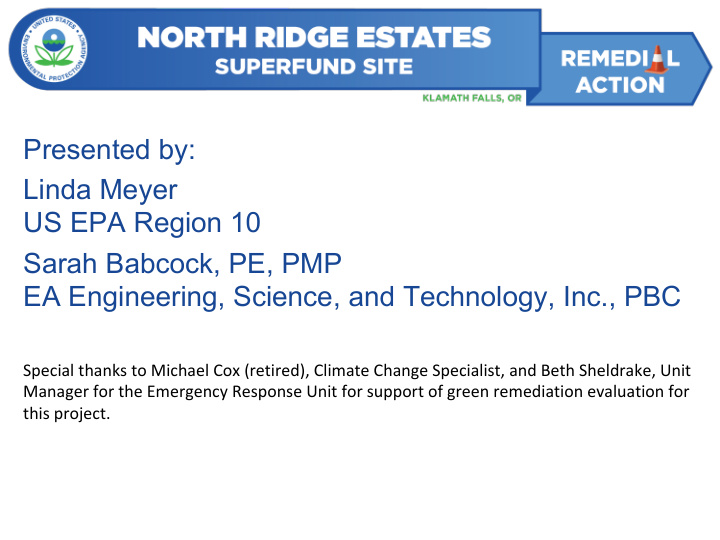



Presented by: Linda Meyer US EPA Region 10 Sarah Babcock, PE, PMP EA Engineering, Science, and Technology, Inc., PBC Special thanks to Michael Cox (retired), Climate Change Specialist, and Beth Sheldrake, Unit Manager for the Emergency Response Unit for support of green remediation evaluation for this project.
Agenda • Site Background • Green Elements of Cleanup – Options considered in design – Final inclusion in specification s • Implementation – Met materials requirements – Challenges with meeting diesel targets • Lessons Learned
Site Background 1944-1946: Marine Recuperative Barracks 82 buildings, accommodating about 5,000 veterans
Cause of Asbestos Contamination • Improper building demolition during residential development • Asbestos containing materials (ACM) debris – Burial pits/waste piles – Surface/sub-surface disp ersal – Steam pipe insulation – Friable and non-friable
• Investigations estimated over 320,000 cubic yards contaminated soil; final number to be closer to 350,000 cubic yards • Contamination can cover football field 150 ft. high • Most places the debris is 2– 4 feet deep, but can be up to 12 feet deep
Green Options Considered • Include reference to Regional “Clean and Green” policy in bid documents • EPA applies ASTM guide and identifies Best Management Practices (BMPs) in bid documents • EPA asks bidders to identify BMPs • EPA asks bidders to apply ASTM guide BMPs after winning bid, before construction
BMP Selection Process • Started with complete list of BMPs in ASTM Standard (160 + BMPs) • 30 BMPs applicable to dig & haul operations – Equipment and fuel – Materials use • 16 final BMPs considered for possible incorporation into remedial design • 4 highest priority BMPs – Minimize diesel emission – Implement idle reduction – Use biodiesel – Use on-site or nearby source for clean fill
Greatest Impacts • Material and Reuse – Local backfill – Revegetate with native plants – Recovered materials – Reuse of existing buildings • Diesel Goals – Off-road equipment – On-road vehicles
BMP: Recycle/Reuse Materials • Chipped trees reused at local bio-mass energy plant • Large trees reused for lumber • Scrap metal recycled • Crushed concrete reused • Reused existing buildings for offices and staff housing • Reused existing storm piping when possible
BMPs: Site Restoration • Local sources of backfill (ODOT borrow pit) • Revegetate quickly (end of each season) • Native, drought resistant plant cover specified. • Biodegradable, recycled se ed matting, straw waddles Other: local staffing and subcontracting
BMPs: Diesel Off-Road Equipment • All engines must meet at least EPA Tier 2 non-road emission standards • Specifications Requirements – Meet Tier 4 (2008 or newer) OR – Retro-fit for 85% reduction in particulate matter (PM) emissions • Season 1: ≥ 25% of equipment • Seasons 2 and 3: ≥ 50% of equipment
BMP: Diesel On-road Vehicles • At least 90% of diesel on- road vehicles : – Engines that meet EPA 2007 on- road emissions standards OR – Emission control technology to reduce PM emissions by at least 85% • Idling reduction plan for all diesel vehicles
13
14
15
On-Road Vehicle Challenges • Local owner-operators with older trucks – Could not afford retrofits (and no long-term incentive) – EPA focus also on use of local labor • New trucks meeting emissions standards we problematic – Short hauls, not at highway speed – Decreased efficiency of work due to “regen”
Specification Language - Flexibility • Materials: “Unless approved otherwise by the RA Construction Manager … ” • Diesel Goals: “If the E&R Contractor can prove to the RA Construction Manager’s satisfaction that for a particular class of onroad diesel vehicle, nonroad construction equipment, or generator, (1) no alternative equipment with a Tier 4 engine is available, (2) it is not technically feasible to meet the control level specified above with a verified device, or (3) installing the control device would create a safety hazard, then the subcontractor, with written approval, may exclude the equipment from the emissions standards.”
BMP Evaluation: Conclusions • Do analysis early in the design phase • Focus on shrinking the remedy’s overall footprint • Review entire BMP list • Identify most applicable and most effective • Consider locational and work activity challenges • Provide incentives in contract language • Incorporate into the project specifications but leave some flexibility
BMP Evaluation: Conclusions • Provide incentives in contract language • Incorporate into the project specifications but leave some flexibility
Questions
Recommend
More recommend